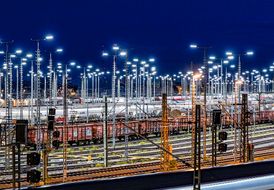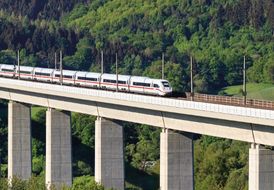Noise remediation and prevention
| NOISE REMEDIATION AND PREVENTION IN GERMANY | 2021 | 2020 | 2019 | |
| NOISE REMEDIATION (EXISTING NETWORK) | ||||
Noise barriers completed (km) | 44.2 | 75.1 | 53.4 | |
Homes with passive measures | 1,820 | 1,485 | 1,628 | |
Track kilometers noise-remediated in total | 2,110 | 2,039 | 1,844 | |
Noise remediation areas relieved | 52.1 | 49.9 | 49.9 | |
| NOISE PREVENTION (NEW CONSTRUCTION AND EXPANSION/UPGRADE PROJECTS) | ||||
Noise barriers completed (km) | 41.2 | 18.4 | 59.7 | |
Homes with passive measures | 590 | 1,173 | 2,261 | |
Since 1999, we have reduced noise pollution for residents living near rail lines through the voluntary noise remediation program for existing Federal rail lines. We are renovating particularly heavily affected lines by means of fixed noise reduction measures no. 25, such as noise barriers, sound-proof windows or noise-proof ventilators in residential buildings. Progress on implementing these measures on affected lines was slightly above our forecast from the 2020 Integrated Report.
Federal budget utilization
In 2021, about € 150 million of Federal budget funds were spent on active and passive noise remediation measures as part of the noise reduction program, with additional noise barriers being installed and additional apartments being fitted with passive measures. In addition, Federal Government funding is being used to finance other special issues in noise reduction, such as the implementation of the measures featured in the feasibility study in the Middle Rhine Valley.
Reduction of trigger values
In 2020, the BMDV announced that the trigger values for noise remediation on existing Federal rail tracks would be reduced by a further 3 dB(A) to 54 dB(A). The corresponding reduction was set out in the 2021 Federal budget. The BMDV announced the publication of the new funding guidelines and the overall noise remediation program for 2022.



